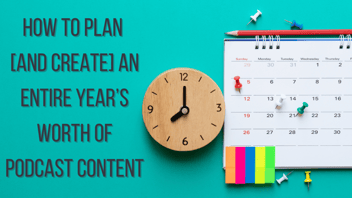Elements of a Podcast Marketing Strategy on a Budget You Can Start

So you’ve banged out some great content on your podcast.
You’ve had several guests, covered a few topics in your niche, and you’re getting the hang of this editing thing.
But you need to start seeing some growth in your numbers and revenue.
What do you do?
With any piece of content (audio/video/blogging), creating the content is only half the battle.
The next half is effectively promoting the piece of content for maximum reach. A podcast marketing strategy does just that.
Marketing does not have to be an expensive, time-consuming endeavor. It could merely be some key action steps.
When done well and consistently, your marketing strategy can increase your listeners, expose your podcast to decision-makers, and increase your revenue.
What is Marketing Strategy?
A marketing strategy is an action plan. It’s a series of steps you or your company will take to get the word out, increase visibility, and by extension, bring in more money. Marketing strategies are typically long-term.
It looks at what resources are available (money, connections, followers, tools) and tries to leverage those connections to grow your business.
In this case, your business is your podcast.
Let’s explore simple ways you can boost your podcast growth using effective Marketing.
Set your Marketing Goals
Before anything substantial happens, you need to set clear marketing goals. These goals should cover how much time, money, and channels you’ll be targeting. More importantly, you should have a clear objective.
This objective could be listener count, downloads, reach, or increased revenue.
A podcast marketing strategy on a budget does not need to be an intricate PowerPoint presentation. Get a simple document up. Write the goals and then the steps you’ll take to get there.
Below, I’ve outlined some critical steps to add to your strategy. Make sure to compile weekly and monthly goals for each.
Above all, any Marketing strategy is dependent on the ability to execute.
Money does not matter if you’re not taking action.
Make sure to add these steps to your plan ASAP:
Plan your marketing goals for each episode
What do you want to happen for each episode? Who do you want to share it with? What type of ads do you want in your content?
If you break down your goals per episode or topic, you can essentially break down your overall strategy into small chunks.
Consider each episode as a soldier out fighting for your overall business or brand.
Focus on improving the quality of your content
For Marketing, nothing beats word of mouth. Word of mouth only comes when you’ve added so much value that your listeners feel compelled to share it with others.
How do you get there?
Make sure to improve the quality of your content.
That may mean improving the depth of your content. It may mean bringing in high-quality guests (will cover that later), investing in better editing or music.
The brand and episodes can market itself only if you spend some time working on the quality going forward.
Distribute across podcast platforms for extended reach
Outline the platforms you’ll be sharing your podcast. Some podcasters or businesses prefer to stick with iTunes or Spotify.
However, there is a range of podcast providers that have untapped audiences.
As part of your strategy, add other podcast repositories like Podbean, Blubrry, Libsyn, Stitcher, or Google Podcasts.
Consider adding your podcast to Alexa as well!
Make sure your episodes are accessible via multiple platforms and test the responsiveness of each.
Repurpose audio for social media
Social media is your most significant opportunity for growth. It’s essential for your marketing efforts. On a budget, consider hiring a VA to help with social media posts, copy, and publishing. Or you can invest in tools like eClincher to schedule social media posts. Here are some available, useful social media posts:
- Share snippets of the podcast on Instagram, Facebook, or LinkedIn
- Go Live for a few minutes while recording the podcast.
- Add images that link to the episode on Facebook and LinkedIn.
- Create slides outlining key points to share on Instagram.
- Record video while podcasting or add a background image and upload it to YouTube.
Social media is a relatively inexpensive way to drive traffic to your podcast and grow your following.
Bundle your best episodes into a lead magnet
While on social media, you would want to give potential listeners the incentive to listen and build your email list.
The best way to do that is a lead magnet, which is a free digital gift. Lead magnets encourage the user to give up their email in exchange for your free gift. With their email in hand, you can send new episodes, content, and promotions directly to them.
Instead of creating new content, place a few of your best episodes as private, and share them with your new subscribers.
The more emails you gather, the more you can scale your marketing efforts. Consider free to inexpensive email marketing tools like Convertkit, Mailchimp, or SendFox.
Consider paid social media marketing for an initial boost.
A lot of business owners underestimate the power of paid ads on social. They aren’t annoying to everyone. They are quite underpriced. The average CPM is down to less than $6, and according to Hootsuite, 1 in 3 persons discover brands from ads.
Put aside a budget for Facebook and Instagram ads. Facebook is especially powerful as it allows you to niche down and target your ideal listener.
About 68% of podcast listeners are more likely to have a post-graduate degree. Furthermore, most podcast listeners have a 250K average household income. You can target specific demographics and keep them engaged with Facebook ads.
Set a budget and test ads as part of your strategy.
Guest podcasting goes both ways.
If guest podcasting is not in your marketing strategy, you should pack up right away. The best way to grow is to leverage other people’s audiences. Guest podcasting also encourages cross-promotion; your guest shares the episode with their audience and vice versa.
Spend a significant chunk of your marketing time and strategy in this area.
Continue to send email outreach to book higher quality guests, even if your show is usually a solo act.
That’s not all. You should be working on getting yourself on popular podcasts in your niche or niche-adjacent.
As part of your strategy, focus on daily outreach and look for ways to collaborate with future guests.
Create a media kit
Let’s not forget the conventional ways of promoting your content. They are still useful and often underused. Journalists and media outlets are always looking for stories and content. You can share your content with them to possibly get in front of a national audience.
For starters, create a media kit. This is a branded document or series of documents that outline your podcast, business, and offerings. This makes it easy for the media outlets to share and repurpose your content in their publications.
You can also use sites like HARO (Help A Reporter Out), Muckrack or Critical Mention to get your podcast in front of decision-makers.
Longterm: Leverage the power of SEO
As part of your strategy, work on Search Engine Optimization or SEO. SEO improves your Google rankings, which can improve your sales. For starters, get a website set-up so you can optimize your episodes for search. Then look for keywords that can enhance your visibility. SEO is a long-term marketing strategy that must not be ignored.
Now go out and do it:
Take some time to plan out your strategy. Make sure to include:
- Set overall marketing goals and goals per episode.
- Work on improving the quality of your podcast.
- Decide on social media platforms, post frequency, and type of posts.
- Create a lead magnet and collect emails.
- Have daily outreach emails and conversations for guest podcasting.
- Website and keywords you’ll be optimizing for SEO.
- Get your media kit ready.
The right strategy can improve your performance, listeners, and download numbers. Soon, that will turn into sales. The good news is that all these can be done with a shoestring budget.
If you need more help with your podcast and growth, connect with me here for more help.





